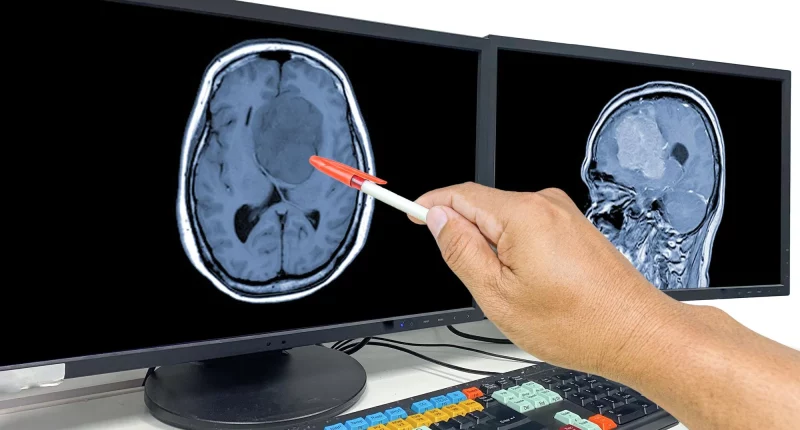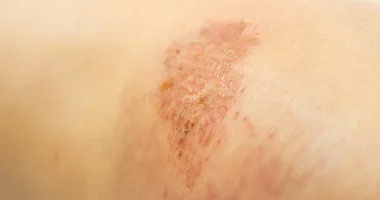Astrocytoma is a kind of brain tumor that arises in cells known as astrocytes. These are star-shaped cells that give nutrition and support to nerve cells in the brain. These tumors can happen at any place in the brain or spinal cord and are categorized based on their grade, ranging from low-grade (grade I or II) to high-grade (grade III or IV), with higher grades indicating more aggressive behavior. Symptoms of astrocytoma can vary depending on the tumor’s location and size, but common signs may include headaches, seizures, cognitive changes, and neurological deficits.
Treatment typically involves a combination of chemotherapy, radiation therapy, and surgery tailored to the tumor’s grade and location, with the goal of removing or reducing the tumor while preserving neurological function. Long-term prognosis varies widely depending on factors such as the tumor grade, extent of surgical resection, and individual patient characteristics.
Symptoms
Symptoms of astrocytoma can vary widely based on the tumor’s size, location, and grade. Common symptoms may include persistent headaches that are often worse in the morning and may be accompanied by nausea and vomiting. Seizures are another hallmark symptom, particularly focal seizures that affect specific parts of the body or cause unusual sensations. Cognitive changes such as memory loss, difficulty concentrating, or personality changes may also occur, especially if the tumor affects areas of the brain involved in higher cognitive functions. Additionally, individuals with astrocytomas may experience neurological deficits such as weakness, numbness, or tingling in the limbs, depending on which areas of the brain or spinal cord are affected by the tumor.
In more advanced stages or with higher-grade tumors, symptoms may worsen and become more pronounced. These can include progressive neurological deficits, such as difficulty with balance and coordination, changes in vision or hearing, and speech difficulties. As the tumor grows and exerts pressure on surrounding brain tissue, individuals may experience increased intracranial pressure, leading to symptoms such as papilledema (swelling of the optic disc), altered consciousness, and even coma in severe cases. It’s important to note that not all individuals with astrocytoma will experience the same symptoms, and some may remain asymptomatic until the tumor reaches a certain size or location that causes noticeable effects on brain function. Regular medical check-ups and imaging studies are crucial for early detection and management of astrocytoma.
Causes
Astrocytoma is primarily caused by genetic mutations that lead to the uncontrolled growth of astrocytes, the star-shaped cells that provide support and nutrition to nerve cells in the brain. While the exact cause of these mutations is not always clear, several factors may contribute to the development of astrocytoma:
Genetic predisposition
In some cases, individuals may inherit genetic mutations that increase their risk of developing astrocytoma. Genetic syndromes such as neurofibromatosis type 1 (NF1) and Li-Fraumeni syndrome are associated with a higher incidence of brain tumors, including astrocytomas.
Exposure to ionizing radiation
Radiation therapy used to treat other conditions, such as childhood leukemia or brain tumors, may increase the risk of developing astrocytoma later in life. Additionally, exposure to high levels of ionizing radiation from sources such as nuclear accidents or certain occupations may also be a risk factor.
Environmental factors
While the role of environmental factors in the development of astrocytoma is not fully understood, some studies suggest that exposure to certain chemicals or toxins may play a role. However, more research is needed to establish a clear link between environmental exposures and astrocytoma risk.
Age and gender
Astrocytomas can occur at any age, but they are more commonly diagnosed in adults between the ages of 45 and 65. There may also be a slight male predominance in the incidence of astrocytoma, although the reasons for this gender difference are not well understood.
Other medical conditions
Certain medical conditions or factors such as immunosuppression due to HIV/AIDS or organ transplantation may increase the risk of developing astrocytoma. Additionally, individuals with a history of certain benign brain tumors, such as pilocytic astrocytoma, may have an increased risk of developing more aggressive forms of astrocytoma later in life.
Risk factors
Several factors may increase the risk of developing astrocytoma, although it’s important to note that having one or more risk factors does not guarantee that an individual will develop the condition. Risk factors for astrocytoma include:
- Age: Astrocytomas can occur at any age, but they are more commonly diagnosed in adults between the ages of 45 and 65.
- Gender: There may be a slight male predominance in the incidence of astrocytoma, although the reasons for this gender difference are not well understood.
- Genetic predisposition: Inherited genetic syndromes such as neurofibromatosis type 1 (NF1) and Li-Fraumeni syndrome are associated with a higher risk of developing astrocytoma.
- Exposure to ionizing radiation: Previous radiation therapy for other conditions, such as childhood leukemia or brain tumors, may increase the risk of developing astrocytoma later in life. Exposure to high levels of ionizing radiation from other sources may also be a risk factor.
- Environmental factors: While the role of environmental factors in astrocytoma development is not fully understood, some studies suggest that exposure to certain chemicals or toxins may increase the risk.
- Other medical conditions: Conditions that weaken the immune system, such as HIV/AIDS or organ transplantation, may increase the risk of developing astrocytoma. Additionally, individuals with a history of certain benign brain tumors may have an increased risk of developing more aggressive forms of astrocytoma.
- Family history: While most cases of astrocytoma are not inherited, having a family history of brain tumors may increase the risk.
It’s important to discuss any potential risk factors with a healthcare provider, as they can provide personalized information and guidance based on individual health history and risk profile.
Diagnosis
Diagnosing astrocytoma typically involves a combination of imaging studies, neurological examinations, and sometimes biopsy. Imaging techniques such as magnetic resonance imaging (MRI) and computed tomography (CT) scans are used to visualize the brain and identify any abnormal growths or lesions. These scans can help determine the size, location, and characteristics of the tumor. A neurological examination may be performed to assess cognitive function, motor skills, reflexes, and sensory perception, which can provide additional information about the tumor’s impact on brain function.
In some cases, a biopsy may be necessary to confirm the diagnosis by examining a sample of tissue from the tumor under a microscope. This can help determine the tumor’s grade and guide treatment decisions. Additionally, molecular testing may be performed to identify specific genetic mutations or biomarkers that can inform prognosis and treatment options. A multidisciplinary team of healthcare professionals, including neurologists, neurosurgeons, oncologists, and radiologists, collaborate to accurately diagnose astrocytoma and develop an appropriate treatment plan tailored to the individual patient’s needs.
Treatment
Treatment for astrocytoma depends on several factors, including the tumor’s grade, size, location, and the patient’s overall health. The main treatment options typically include operation, radiation therapy, and chemotherapy, often used in combination. Surgery aims to eliminate as much of the tumor as best while reducing damage to surrounding healthy brain tissue. In cases where complete removal is not feasible, surgery may still be performed to obtain a tissue sample for diagnosis and to relieve symptoms caused by the tumor’s mass effect. Following operation, radiation therapy may be used to target any remaining tumor cells and reduce the risk of recurrence.
Chemotherapy may also be recommended, either alone or in combination with radiation therapy, particularly for higher-grade astrocytomas that are more likely to recur or spread. Targeted therapy and immunotherapy are emerging as additional treatment options, particularly for tumors with specific genetic mutations or biomarkers. Treatment decisions are made collaboratively by a multidisciplinary team of healthcare professionals, taking into account the individual patient’s preferences and circumstances, with the goal of maximizing tumor control while minimizing side effects and preserving neurological function. Regular monitoring and follow-up care are essential to assess treatment response, manage side effects, and detect any signs of tumor recurrence or progression.
Prevention
Preventing astrocytoma largely involves minimizing exposure to known risk factors. While some risk factors such as age and genetic predisposition cannot be controlled, efforts to reduce exposure to ionizing radiation, environmental toxins, and other potential carcinogens may help lower the risk. This includes avoiding unnecessary radiation exposure, such as excessive medical imaging or occupational exposure to radiation, and minimizing exposure to known environmental toxins whenever possible.
Regular health screenings and check-ups can also aid in early detection and prompt management of any potential precursor conditions or risk factors. Additionally, maintaining a healthy lifestyle with a balanced diet, regular exercise, and avoiding tobacco and excessive alcohol consumption may contribute to overall well-being and potentially lower the risk of developing astrocytoma. However, given the complex and multifactorial nature of cancer development, there are no guaranteed preventive measures, and individuals should consult with healthcare professionals for personalized risk assessment and guidance.
Summary
Astrocytoma, a type of brain tumor arising from astrocytes, presents with varied symptoms including headaches, seizures, and cognitive changes. Causes include genetic predisposition, radiation exposure, and environmental factors. Diagnosis involves imaging, neurological exams, and sometimes biopsy.
Treatment comprises operation, radiation therapy, and chemotherapy, tailored to tumor grade and location. Prevention focuses on minimizing exposure to risk factors such as radiation and toxins, along with healthy lifestyle choices. Regular screenings aid in early detection, emphasizing the importance of collaborative care in managing astrocytoma.








